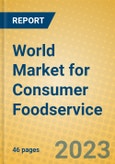Consumer foodservice posted growth in 2023 despite uncertain economic conditions and high inflation in many markets. In some, high prices have led to slowing transactions growth and growing transaction sizes. In others, deals offered by restaurants hoping to attract consumers have driven transaction sizes down. Overall, globally consumers are looking for value for money, not only in terms of lower prices, but in terms of buying unique and specialised experiences for every dollar they spend.
Key findings
New recovery in Asia, market recovers value wise overall
The consumer foodservice industry continues to recover globally, pushed forward by strong growth in the Asia Pacific region following the lifting of COVID-era restrictions. High inflation in many markets globally has spurred value sales recovery in current terms to 2019 levels, but constant sales will not recover until 2025.
Inflation and menu price increases lead to slowed transaction growth
High inflation in many markets leading to high prices and wider economic uncertainty have caused mixed effects. While across the board consumers are looking for value, in some markets this has led to decreased spend per transaction as brands offer deals. In others, transaction size is growing as prices have increased and consumers have cut back on eating out.
Persistent labour shortages and tech to help
Following dramatic shifts in the labour market during the height of the COVID-19 pandemic and increased wages, many markets have struggled to fill positions. To address these concerns many restaurants have looked to implement technology that can cut down on labour requirements.
Personalisation and loyalty
The ever-increasing digitalisation of the foodservice industry has allowed consumers to connect with their favourite brands online. This has led to innovation in online loyalty programmes and demand from consumers for personalisation.
Chained LSR continues global expansion to new markets, secondary cities
Top chains continue to expand globally through outlet development. As this competition remains high, brands are looking to gain first-mover advantage in untapped markets in Asia, the Middle East and Africa, oftentimes targeting second-tier cities without a large chained restaurant presence.
The World Market for Consumer Foodservice global briefing offers an insight into to the size and shape of the Consumer Foodservice market, highlights buzz topics, emerging geographies, categories and trends as well as pressing industry issues and white spaces. It identifies the leading operators and brands, offers strategic analysis of key factors influencing the operating environment - be they economic/lifestyle influences, new foodservice concepts, outlet locations, menu innovation or format development. The entire industry is considered, including both chained and independent operators. Forecasts illustrate how the market is set to change and what is the criteria for success.
Product coverage: Consumer Foodservice by Fulfillment, Consumer Foodservice by Location, Consumer Foodservice by Ordering Platform, Consumer Foodservice by Type.
Data coverage: Market sizes (historic and forecasts), company shares, brand shares and distribution data.
Why buy this report?
- Get a detailed picture of the Consumer Foodservice market
- Pinpoint growth sectors and identify factors driving change
- Understand the competitive environment, the market’s major players and leading brands
- Use five-year forecasts to assess how the market is predicted to develop.








